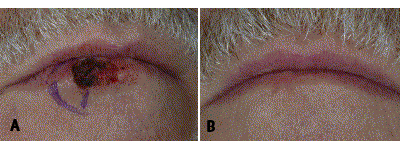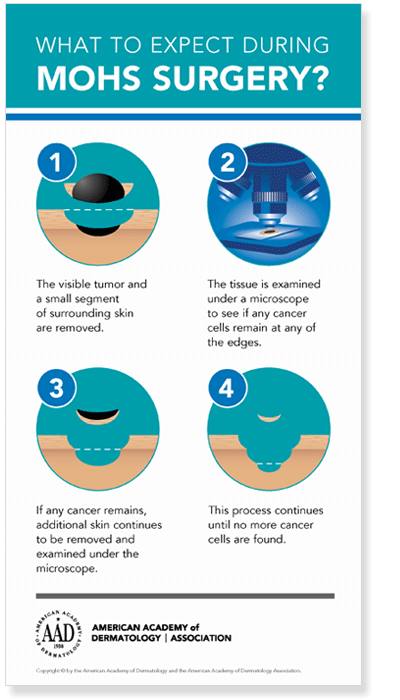What is Mohs surgery?
Used to treat skin cancer, this surgery has a unique benefit. During surgery, the surgeon can see where the cancer stops. This isn’t possible with other types of treatment for skin cancer.
The ability to see where the cancer stops gives Mohs (pronounced Moes) two important advantages:
- Mohs has a high cure rate.
- Mohs allows you to keep as much healthy skin as possible because the surgeon only removes the skin with cancer cells. This is especially important when skin cancer develops in an area with little tissue beneath (e.g., eyelid, ear, or hand).
What is it like to have Mohs surgery?
If you have Mohs surgery, you’ll see a doctor who is a trained Mohs surgeon. Our Mohs surgeons, Dr. Malika Tuli and Dr.John Huber are dermatologists who have completed extensive training in Mohs surgery. Dr.Tuli and Dr.Huber are double board certified in dermatology and Mohs micrographic dermatologic surgery.
On the day of the surgery, your surgeon will first examine the area to be treated. You’ll then be prepped for surgery. This includes giving you an injection of anesthetic. This injection only numbs the area that will be operated on, so you’ll be awake during the surgery.
Once the anesthetic takes effect, the surgery can begin. The surgeon starts by first cutting out the visible skin cancer. Next, the surgeon removes a thin layer of surrounding skin. You’re then bandaged so that you can wait comfortably.
While you wait, the Mohs surgeon looks at the removed skin under a microscope. The surgeon is looking for cancer cells. If cancer cells are found, you’ll need another layer of skin removed.

Some wounds heal without stitches.
A: The Mohs surgeon didn’t stitch the wound on this man’s lip.
B: 6 weeks later, the wound has healed on its own.
This process of removing a thin layer of skin and looking at it under a microscope continues until the surgeon no longer sees cancer cells.
Once cancer cells are no longer seen, your surgeon will decide whether to treat your wound. Some wounds heal nicely without stitches. Others need stitches. To minimize the scar and help the area heal, some patients require a skin graft or other type of surgery.
If you need wound treatment, your Mohs surgeon may treat the wound that same day. Some patients with a large wound are referred to another surgeon for wound treatment.
When is Mohs surgery recommended?
Most Mohs patients have a common type of skin cancer like basal cell carcinoma (BCC) or squamous cell carcinoma (SCC). Mohs is usually recommended when a BCC or SCC:
- Is aggressive or large
- Appears in an area with little tissue beneath it (e.g., eyelid, nose, ear, scalp, genitals, hand, or foot)
- Was treated and has returned
Mohs Surgery Patient Education by American College of Mohs Surgery

